 |
Picks is a monthly sampling of Japan's art scene, offering commentary by a variety of reviewers about exhibitions at museums and galleries in recent weeks, with an emphasis on contemporary art by young artists. |
 |
 |
 |
3 September 2012 |
 |
| 1 | 2 | |
 |
|
 |
 |
|
|
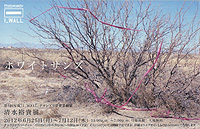 |
 |
|
| Yuki Shimizu: White Sands |
| 25 June - 12 July 2012 |
Guardian Garden
(Tokyo) |
 |
| In this solo show by the winner of the Grand Prix at Recruit's fifth "1_WALL" photo competition, what stands out is the fact that Shimizu appends a text to each of his works. Moreover, the words are not mere appurtenances to the images, but an integral part of their impact. Shimizu's approach suggests that it is not always true that a picture is worth a thousand words: the synergy of words and pictures can create entirely new perspectives. Perhaps we need more artists willing to venture in this direction. |
|
|
 |
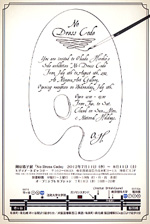 |
 |
|
| Hiroko Okada: No Dress Code |
| 11 July - 11 August 2012 |
Mizuma Art Gallery
(Tokyo) |
 |
| On the gallery wall hang relief-like, amorphous jumbles of stiff, crunchy cloth on which images have been painted. The material is painter's canvas reworked into shapes vaguely resembling brassieres, stockings and other articles of underclothing, while the blobs of paint on the surface are reminiscent of salmon roe or vomit. On the gallery floor sits a dining table in the shape of an artist's palette, set with two pairs of knives and forks in primary colors. This curious deconstruction of the elements that go into painting somehow succeeds in forcefully evoking the human essentials of clothing and food. |
|
|
|
|

|
 |
 |
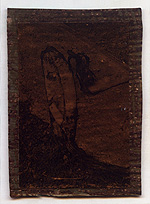 |
 |
| Kota Kishi: Barracks |
| 19 July - 10 August 2012 |
photographers' gallery / Kula Photo Gallery
(Tokyo) |
 |
| For this show Kishi was not content to merely mount his straightforward snapshots of the flophouse districts of Sanya, Kotobukicho, and Kamagasaki; here he affixed the prints directly to scraps of tile and wood, plastic junk, and other detritus he picked up in the neighborhoods he photographed. On the one hand this installation-like approach seemed like something that might occur to someone off the top of his head in the course of an idle stroll; on the other, it amply conveyed Kishi's intention to somehow return these images to the environments he originally "stole" them from. |
|
|
 |
 |
 |
| The Cosmos as Metaphor |
| 20 July - 1 September 2012 |
|
Hotel Anteroom Kyoto / Taka Ishii Gallery Kyoto
(Kyoto)
|
 |
| Held concurrently in two Kyoto venues, a hotel and a gallery, this show curated by Reiko Tsubaki of Mori Art Museum featured 12 contemporary artists (11 Japanese and one German). Of the works displayed in the hotel lobby, the most striking was umbra, a collaborative production by Yoshitaka Yazu and Tomohiko Okita that utilized 3D imaging technology. Viewed through 3D glasses, tree branches, fire, and smoke seemed to protrude right into the exhibition space, affording a mystical, even cosmic experience befitting the show's otherwise somewhat murky title concept. |
|
|
|
|
|
|
|

|
 |
 |
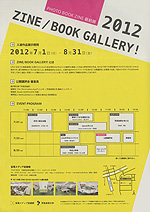 |
 |
| ZINE / BOOK GALLERY! 2012 |
| 1 July - 31 August 2012 |
Takarazuka Media Library
(Hyogo) |
 |
| An event that brings together handmade and/or self-published photo books, "ZINE / BOOK GALLERY!" took place this summer in the same venue in Takarazuka, outside Osaka, where it made its debut last year. On display were 66 works selected from 123 entries, as well as another 28 included by invitation, mostly from among last year's participants. About half of the total were actually available for purchase on-site.
|
|
|
 |
 |
| Kentaro Kurihara + Miho Iwatsuki / studio velocity |
| 21 July - 5 August 2012 |
Nagakute Campus, Aichi Shukutoku University
(Aichi) |
 |
| The Aichi-based architect duo that works under the name studio velocity held this on-campus exhibition under the auspices of the Urban Architectural Design Department at Aichi Shukutoku University. Titled "Creating Architecture Like Plant Ecosystems that Change Shape with the Environment," the show was a surprisingly large-scale effort replete with models, panels, and installations. Working directly with the artists to put on a show from scratch -- a departure from the usual college pattern of hosting traveling exhibitions -- was surely an optimum learning experience for the students involved. |
|

|
 |
 |
 |
 |
|
| Art Picnic Vol. 2: Breathing Art |
| 9 June - 29 July 2012 |
Ashiya City Museum of Art and History
(Hyogo) |
 |
| Works that might be considered a form of outsider art made up much of this exhibition on the theme of art found in the quotidian. In the entrance hall one encountered Yukinori Yamamura's video piece "Ashiya Calisthenics No. 1," which portrays the Yamamura family, dressed in tights and waving green pom-poms (apparently in homage to the Ashiya City Tree, the black pine) at various famous sites around the city. Accompanying the video was the artist's live performance of calisthenics in front of the screen. This and a number of other works lovingly conveyed the natural rhythms of day-to-day living and breathing. |
|
|
 |
 |
 |
| The 400 Years of Nihonbashi |
| 26 May - 16 July 2012 |
Edo-Tokyo Museum
(Tokyo) |
 |
| Subtitled "The Foremost Landmark of Edo-Tokyo Seen in Art," this show testified to the prominent position of the fabled bridge and its environs in countless illustrations from the Edo period on. Pride of place went to Utagawa Hiroshige's astoundingly avant-garde hyper-closeup view of the span. The exhibition included images created well into the modern era, but stopped in the sixties, when an expressway was built directly over the bridge. Interestingly, though, the show maintained a studiously neutral stance on the current controversy over whether or not to dismantle the expressway so as to restore Nihonbashi to some semblance of its past glory. |
|
|
|
|
|
|
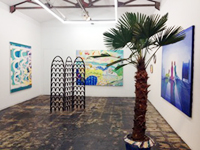 |
 |
| Aya Ito: Hahaha at Hyperspeed |
| 20 July - 1 September 2012 |
Tomio Koyama Gallery Kyoto
(Kyoto) |
 |
| Ito uses a process she calls "photo-drawing" in which she constructs models, shoots numerous photos, and scrutinizes the visual impact of a composition before she actually starts painting it. This solo show introduced a number of new works created in this manner, as well as a scattering around the gallery of ceramic and papier-mache sculptures that reference the paintings. Augmenting the works on the wall with objects (including a tree) that resonated with their motifs and images was a clever strategy that made for a full-fledged installation. |
|
 |
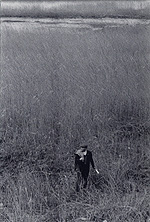 |
 |
| Yukichi Watabe: Criminal Investigation |
| 26 June - 8 July 2012 |
TAP Gallery
(Tokyo) |
 |
| Watabe (1924-93) is best known for his documentary photography of such far-flung places as Alaska and Egypt, as well as series like Kagura shot in locations throughout Japan. In 1958 Watabe got permission to spend 20 days photographing two detectives working on a notorious murder case in which a dismembered body was discovered by a lake north of Tokyo. Watabe's noirish camerawork on this project was only recently rediscovered, resulting in a much-heralded book published in France, not Japan -- but this show should help restore the remarkable series to its rightful place in the domestic pantheon. |
|
|
|
|
 |
|